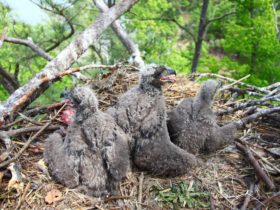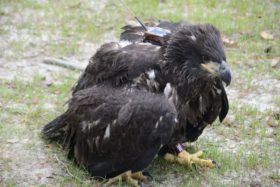No avian pox
Have HE and HK left?
July 26, 2009Satellite map July 20 to July 27
July 28, 2009
Categories


 Last week the question was asked as to whether this year’s young eagles showed any signs of avian pox. An excellent question considering that is what sent the 2008 eagle chick to the Wildlife Center of Virginia. When the youngest female (HE) jumped out of the nest on June 2, I kept her overnight and gave her a good look over. Avian pox usually grows on soft tissue on the feet, eye liner and beak. HE had no signs of avian pox. Today Azalea (HH) sat on the front branch of the nest tree and I got good close-ups with the web camera. She also shows no signs of avian pox. As for HK, he appears to have left the area so I will have to look through recent photos in my archive, but I do not recall seeing any signs of pox on him.
Last week the question was asked as to whether this year’s young eagles showed any signs of avian pox. An excellent question considering that is what sent the 2008 eagle chick to the Wildlife Center of Virginia. When the youngest female (HE) jumped out of the nest on June 2, I kept her overnight and gave her a good look over. Avian pox usually grows on soft tissue on the feet, eye liner and beak. HE had no signs of avian pox. Today Azalea (HH) sat on the front branch of the nest tree and I got good close-ups with the web camera. She also shows no signs of avian pox. As for HK, he appears to have left the area so I will have to look through recent photos in my archive, but I do not recall seeing any signs of pox on him.




2 Comments
Mr. Lukei: Might the transmitter be causing Azalea’s (HH) apparent lack of independence? Is she more dependent because she is less flexible and can’t maneuver as well? Many thanks to you and your team. Susan
Susan
Azalea (HH) was the last to fledge and may just be taking longer to adapt to her freedom. CCB biologists have fitted transmitters on over 60 eagles and there is no indication that the transmitter interferes with either their development or ability to maneuver.